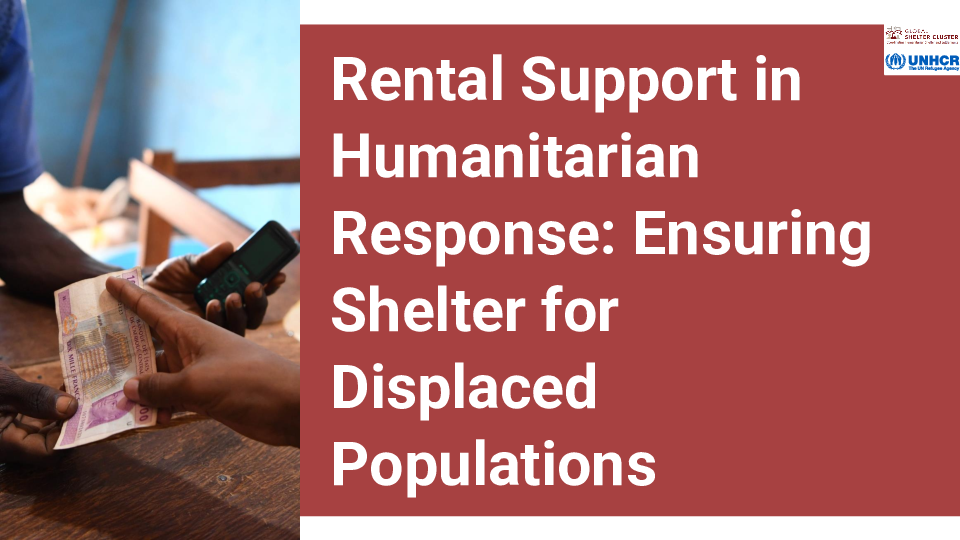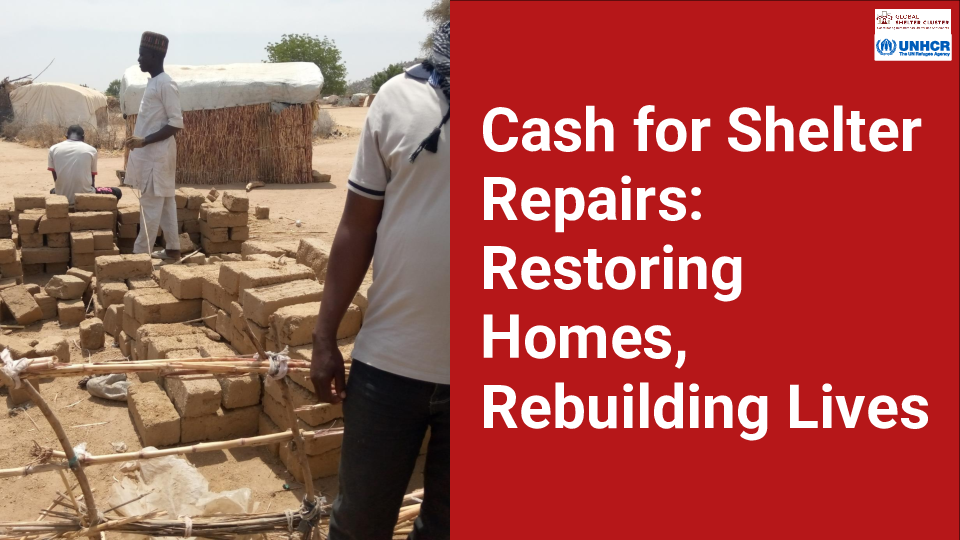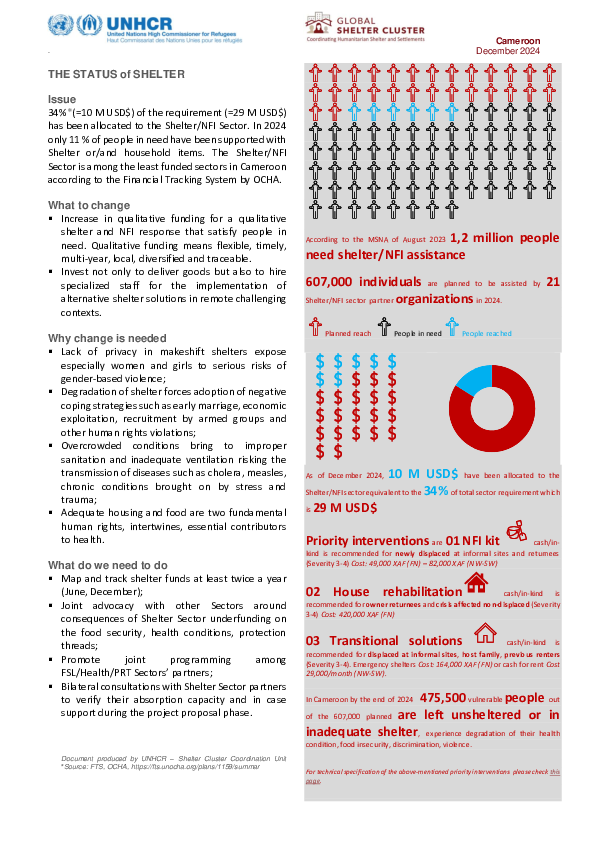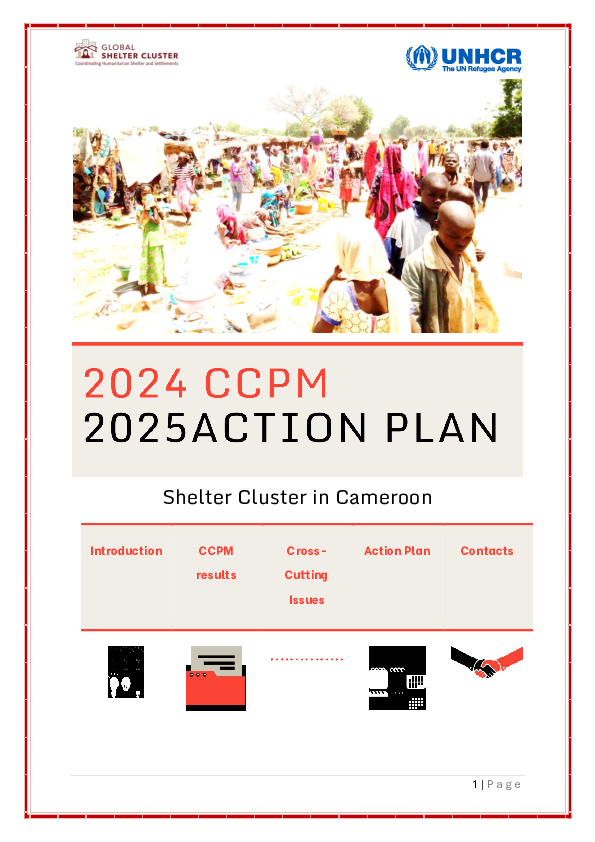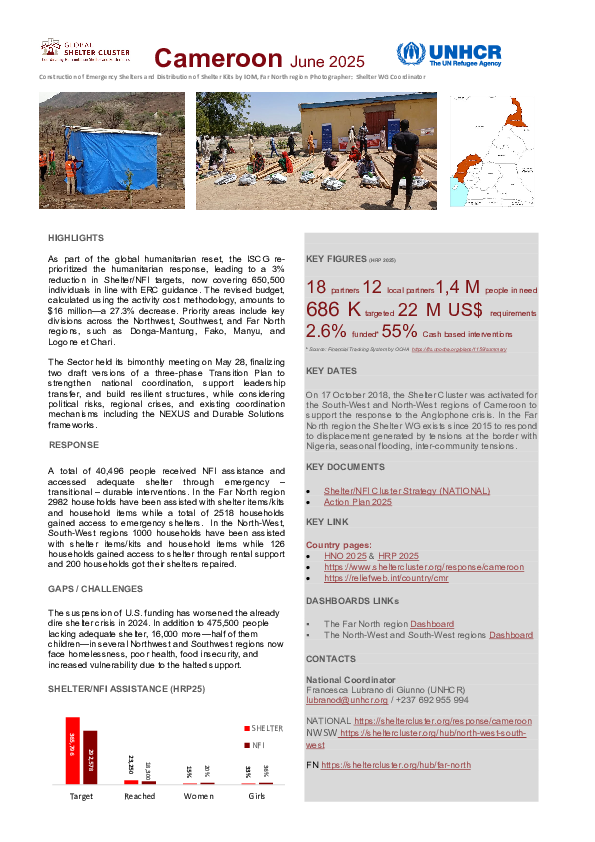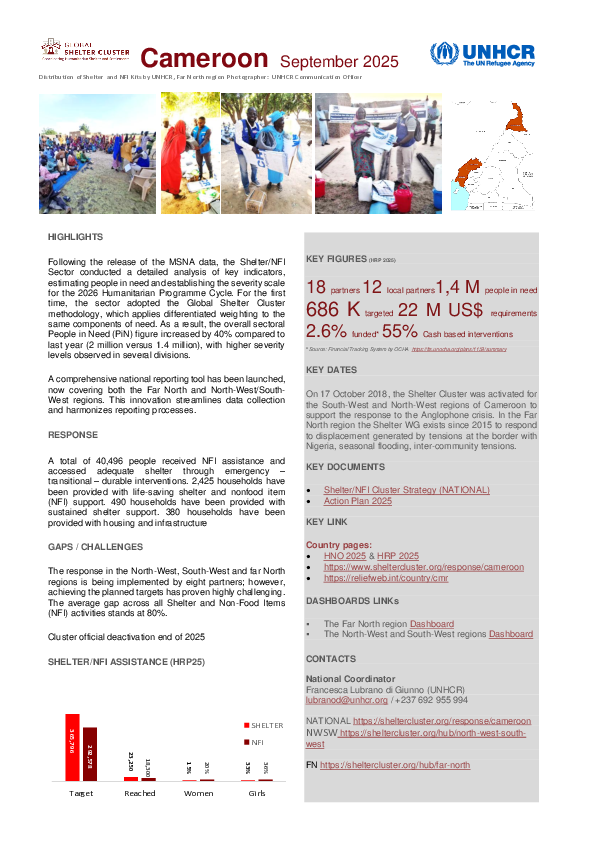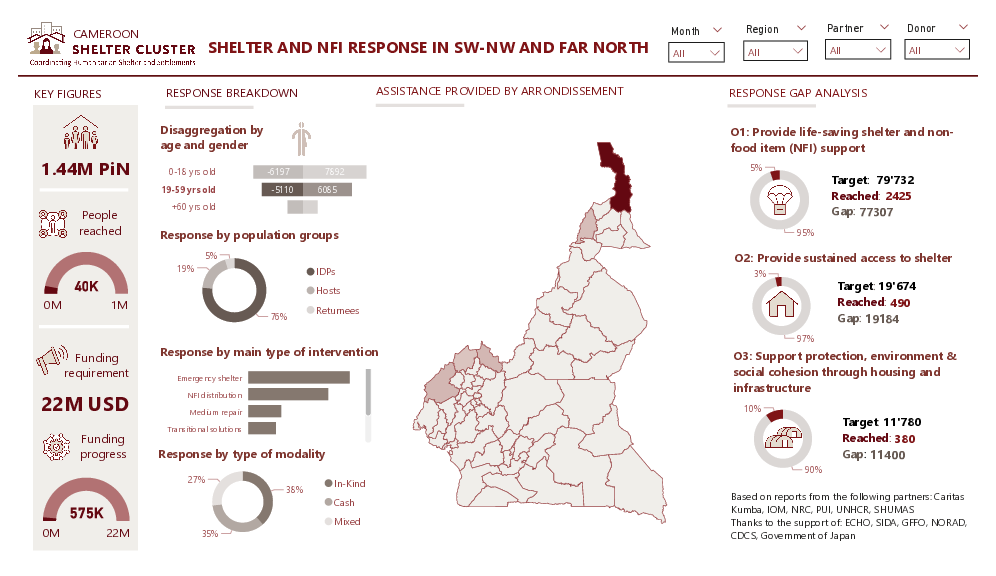Cameroon
Featured Documents
Overview
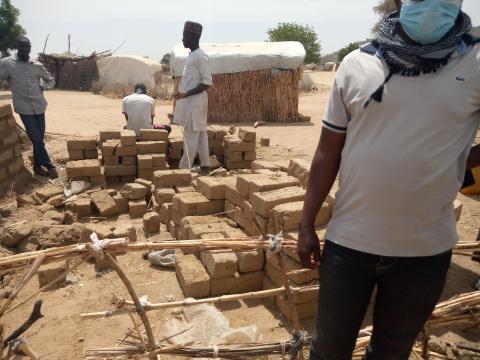
On the 17th of October 2018, the Shelter Cluster was activated for the South-West and North-West regions to support the response to the recent crisis. The cluster is led by UNHCR. while in the Far North and at the national level, UNHCR leads coordination through a sectorial approach since 2015.
Some 2 million people living in Cameroon are in need of humanitarian assistance and protection due to the effects of conflict and violence, climate shocks, and disease outbreaks. The prolonged nature of the Lake Chad basin conflict, the North-West and South-West crisis, and the impact of the Central African Republic (CAR) refugee crisis are compromising affected populations well-being and living conditions. There are nearly one million internally displaced people (IDPs). The country is also hosting nearly half a million refugees and asylum seekers. Humanitarian needs are compounded by structural development weaknesses and chronic vulnerabilities. New or multiple displacements and insufficient humanitarian assistance contribute to the considerable erosion of the already limited resilience of the affected population and to enduring humanitarian needs. Protection needs are widespread: women and girls are at high risk of Gender-Based Violence (GBV) and men and boys are most exposed to arbitrary arrest and detention, death, and injury. Over 2.5 million people are facing acute food insecurity. In line with the global guidance,2 which indicates that only populations affected by crises are to be included in the inter-sectoral needs and severity analysis, the following population groups are considered in this overview: IDPs, Returnees, Refugees, Host communities, and ‘Those left behind’, who are people affected by a crisis/shock but who do not flee nor host IDPs and/or refugees. ‘Those left behind’ often were not able or willing to flee, some because of old age and disabilities, and they have been identified as one of the most vulnerable groups.[1]
In 2025 a total of 1,441,626 Cameroonians will need adequate shelter and household items. It is estimated that since the beginning of the Lake Chad basin conflict in 2014 and the North-West and South-West crisis in 2016/2017 a total of 9,223 properties were intentionally burnt, depriving people of the right to housing[1].
Inadequate shelter refers to housing that fails to meet basic standards of safety, space, privacy, and protection from environmental conditions. This may include structures that are damaged, overcrowded, lack essential household items, or are made from temporary materials unable to withstand natural elements or provide security. For displaced individuals, returnees, and vulnerable host communities, inadequate shelter has cascading impacts on nearly every facet of daily life:
- Insufficient shelter can limit access to food storage and safe cooking spaces, increasing food insecurity. Lack of refrigeration or proper storage encourages spoilage and waste, while overcrowded conditions often force people to eat less or rely on emergency rations, which may lack adequate nutritional value.
- Poor shelter exposes individuals to the elements, increasing vulnerability to illnesses like respiratory infections, waterborne diseases, and heatstroke. Overcrowding heightens the risk of communicable diseases such as tuberculosis, and the lack of NFIs like blankets and proper bedding worsens health risks, especially in extreme temperatures.
- Inadequate shelter compromises the safety and security of residents, particularly women, children, and the elderly. Poorly constructed or crowded spaces increase risks of violence, abuse, and exploitation. For vulnerable individuals, a lack of privacy amplifies psychological stress and fear of harassment.
- Living in substandard conditions impacts personal dignity, as people are often deprived of privacy and basic comforts. Overcrowding in shelters limits individuals’ ability to carry out normal routines and care for their families, diminishing self-respect and eroding community cohesion.
- Structural instability and lack of protective materials put residents at risk of physical harm. Unstable shelters are vulnerable to collapse, especially in adverse weather, increasing the likelihood of injuries. In conflict zones, shelters without proper barriers can expose inhabitants to direct violence.
- Inadequate shelter limits access to vital services such as water, sanitation, and healthcare. Overcrowded and poorly ventilated living conditions exacerbate these limitations, as shelters may not have the necessary infrastructure for clean water or waste management, which raises risks of disease and undermines community health.
- Children in inadequate shelters often lack a conducive environment for learning. Without quiet spaces, electricity, or educational materials, children struggle to keep up with schooling, leading to long-term consequences for their academic development and future opportunities.
- Poor shelter conditions create strain on local infrastructure, as overcrowding and displacement increase demand for water, sanitation, and waste services. The lack of proper infrastructure compounds issues, leading to deteriorating roads, overwhelmed health clinics, and unsanitary conditions, further intensifying the challenges faced by vulnerable populations.
Despite the above-mentioned issues Shelter is rarely considered a priority need by vulnerable people in Cameroon except in the aftermath of natural disaster such as floods. According to last MSNA Shelter comes as forth priority only after food, water, and livelihood in the Far North region while in the North-West and South-West regions Shelter comes as fifth priority after Food, Education, Water, Livelihood.
According to data collected during the last Multisectoral Needs Assesment the Shelter Sector has identified Lagone et Chari, Mayo Sava and Mayo Tsanaga, Donga Mantung, Bui, Mezam, Kupe, Meme, Fako as the divisions that present the highest concentration of people in need while Mayo Danay and Lagone et Charie are the divisions with the highest severity of needs where people are experiencing severe shelter inadequacies.
Cameroon’s complex humanitarian landscape—marked by protracted displacement due to ongoing conflict in the Far North, the Lake Chad Basin, and the North-West and South-West regions—has led to deteriorating conditions for both displaced and not displaced populations.
One of the most significant trends observed is the increased shelter and NFI needs of non-displaced individuals in the NW-FN regions and returnees in the NW region. Historically, the Internally Displaced Persons (IDPs) have represented the largest group in need within this sector. However, as livelihood is challenging at locations of displacement, an increasing number of individuals are returning to their communities, leading to a growing demand for shelter rehabilitation, reconstruction, and NFIs to support reestablishment in these regions. These returnees are frequently met with homes and infrastructure that have been severely damaged or destroyed, lacking the necessary means to reconstruct or repair their housing independently.
For non-displaced populations, the prolonged hosting of displaced individuals has created a significant strain on resources, depleting household assets, and creating new vulnerabilities within these communities. Many of these hosts have shared limited resources for years, leading to heightened shelter degradation and a scarcity of basic NFIs. As a result, the distinction between displaced and non-displaced populations in terms of shelter and NFI needs has blurred. In areas like the Far North, recurring natural hazards such as flooding further compound these issues, with many families left without adequate shelter, making them more vulnerable to health risks and further displacement.
For IDPs, although needs remain critical, particularly in informal settlements and host communities, there is evidence that shelter conditions have somewhat stabilized in certain areas due to ongoing humanitarian interventions. Yet, overcrowding and an inadequate supply of NFIs continue to pose serious challenges. In overcrowded settings, basic privacy and safety are compromised, increasing protection concerns, particularly for women, children, and vulnerable individuals.
The loss of shelter and household items influences the physical and mental well-being of people with greater consequences on children, older people, pregnant/lactating women, and persons living with disabilities. Degradation of shelter forces adoption of negative coping strategies such as early marriage, economic exploitation, recruitment by armed groups and other human rights violations.
Faced with repeated displacements and the lengthening duration of them, the population is increasingly vulnerable and most of the time in need of durable solutions such as integration or relocation. The same family could be displaced in the first place due to the conflict generated by armed groups and then displaced again because of heavy floods or intercommunal tensions.
The shortage of essential household items is also a critical driver of inadequacy. In addition to overcrowding, Shelter Cluster partners have found that larger families are sometimes forced to share mosquito nets and mattresses and often there are not enough sleeping places. The comfort inside the shelter is essential to gain a minimum of dignity and psychological stability especially after a forced displacement.
Lake Chad Bassin Crisis[2]
In the Far North (FN) region, the shelter, and Non-Food Item (NFI) needs are critical, impacting a population comprising 359,093 Internally Displaced Persons (IDPs), 90,547 returnees, and 237,463 non-displaced people. Shelter conditions are precarious, with 46 per cent of shelters damaged, especially the roof structure, particularly in the Lagone et Chari areas. Natural hazards and ongoing structural degradation are the main causes of shelters inadequacy, exposing people to heightened risks.
Most people, especially in areas like Mayo Kani, Mayo Danay, and Mayo Sava, live in cramped conditions, with less than 3.5 square meters of space per person, below the minimal humanitarian living standard. Rental costs add further strain, averaging 20,000 XAF monthly, with the highest prices reported in Lagone et Charie (30,000 XAF). For those returning to their areas of origin, access to farmland remains the primary driver, followed by the relative safety these locations offer. However, limited resources and damaged infrastructure mean returnees often face challenging conditions with insufficient shelter and minimal access to NFIs. According to what reported by households interviewed mats are the least accessible items in the Far North region.
North-West and South-West crisis[3]
In the North-West and South-West (NW-SW) regions, a significant shelter, and Non-Food Item (NFI) crisis persists. With a total of 231,674 Internally Displaced Persons (IDPs), 342,472 returnees, and a non-displaced population of 116,613 in need, the demand for adequate shelter and essential NFIs is critical. Currently, 34 per cent of shelters in the area are damaged, especially the roof structure, compromising safe and secure living conditions. According to what reported by households interviewed the main causes of damage are lack of maintenance and accidents during conflict activity. Damages are spread across divisions in equal measure with slightly higher percentage in Bui and Meme. Additionally, 31 per cent of the population resides in spaces smaller than 3.5 square meters per person, falling below the minimal humanitarian standard for living space. In the Far North rental costs average 43,000 XAF with a maximum of 80,000 XAF in Manyu.
Returnees, largely driven by the need to access farmland and a relative sense of safety in their home areas, face pressing challenges in reconstructing their lives. The lack of livelihood opportunities at displacement locations further motivates returns, although returnees often encounter inadequate housing and insufficient resources for rebuilding. The strain on existing shelters intensifies the need for NFI support, as many households lack essential items to sustain basic hygiene, cooking, and daily living.
According to what reported by households interviewed blankets are the least accessible items in the North-West and South-West regions.
Littoral and West regions
In the West and Littoral, a total of 53,764 Internally Displaced Persons (IDPs) in need of shelter/ NFI is assessed.
Bamboutus, Moungo and Noun Divisions were found to be in severity phase 3 with 60 per cent of the IDPs renting and 22 per cent hosted by community members. The majority (73 per cent) of IDPs are living in mudbrick houses especially in Bamboutus and Noun divisions, and also in wood houses (50 per cent) especially in Moungo division. The Shelter conditions are poor with 29 per cent of IDPs living in damaged shelters and 6 per cent living in unfinished shelter. Around 60 per cent of the IDPs population are renting by spending most of their income and 39 per cent among those renters have not entered into a formal agreement with the tenant.
[1] One of the sub-indicators to measure shelter adequacy is whether the residential unit has been intentionally damaged. This factor, together with the Global Human Settlement Layer data (satellite imagery), highlight the prevalence of the problem and the estimated number of residential buildings that were affected in each subdivision impacted by the crisis.

